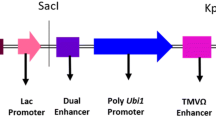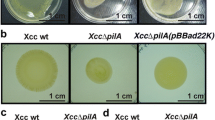Abstract
Key message
Overexpression of insecticidal pilin subunit from Xenorhabdus nematophila protects transgenic tobacco and tomato plants against Helicoverpa armigera.
Abstract
Xenorhabdus nematophila is a pathogenic bacterium producing toxins that kill the larval host. Previously, we characterized a pilin subunit of X. nematophila which was found to be a pore-forming toxin and cytotoxic to the larval hemocytes of Helicoverpa armigera by causing agglutination and lysis of the cells. In the present study, we report the efficacy of the insecticidal pilin subunit expressed in transgenic tobacco and tomato plants for control against H. armigera. A 537 bp mrxA gene encoding the 17 kDa insecticidal pilin subunit was transferred into the genome of tobacco and tomato, respectively, via Agrobacterium-mediated transformation. The stable integration of the 537 bp mrxA gene in the transgenic plants was confirmed by Southern blot analysis and expression of mrxA gene was confirmed by RT-PCR and Western blot analyses. The transgenic plants appeared healthy and phenotypically normal but proved toxic to the insects in insect bioassays, showing 100 % insect mortality and reduced damage of the transgenic plants. Based on these observations, it is suggested that pilin subunit can be used as a potential candidate for control of H. armigera and may open new strategies for pest control in agricultural plants.




Similar content being viewed by others
Abbreviations
- UC:
-
Untransformed control
- VC:
-
Vector control
References
Akhurst RJ (1982) Antibiotic activity of Xenorhabdus spp. bacteria symbiotically associated with insect pathogenic nematodes of the families Heterorhabditae and Steinernematidae. J Gen Microbiol 128:3061–3066
Akhurst RJ, Dunphy GB (1988) Symbiotically associated entomopathogenic bacteria, nematodes and their insect hosts. In: Beckage N, Thompson S, Federici B (eds) Parasites and pathogens of insects, vol 2. Academic Press, New York, pp 1–23
Arora S, Kanojia AK, Kumar A, Mogha N, Sahu V (2012) Biopesticide formulation to control tomato lepidopteran pest menace. Curr Sci 102:1051–1057
Arora S, Kanojia AK, Kumar A, Mogha N, Sahu V (2014) Biopesticide formulation to control tomato lepidopteran pest menace. Asian Agric Hist 18:283–293
Banerjee J, Singh J, Joshi MC, Ghosh S, Banerjee N (2006) The cytotoxic fimbrial structural subunit of Xenorhabdus nematophila is a pore-forming toxin. J Bact 188:7957–7962
Bedding RA, Akhurst RJ (1975) Nematodes and their biological control of insect pests. Nematologia 21:109–110
Beveridge TJ (1999) Structures of gram-negative cell walls and their derived membrane vesicles. J Bacteriol 181:4725–4733
Boemare NE, Akhrust RJ (1988) Biochemical and physiological characterization of colony from variants in Xenorhabdus ssp. (Enterobacteriaceae). J Gen Microbiol 134:1835–1845
Bradford M (1976) A rapid and sensitive method for the quantitation of microgram quantities of protein utilizing the principle of protein-dye binding. Anal Biochem 72:248–254
Bravo A, Soberon M (2008) How to cope with insect resistance to Bt toxins. Trends Biotechnol 26:573–579
Brookes G, Barfoot P (2009) Global impact of biotech crops: socio-economic and environmental effects, 1996–2007. Outlooks Pest Manag 20:258–264
Brown SE, Cao AT, Hines ER, Akhurst RJ (2004) A novel secreted protein toxin from the insect-pathogenic bacterium Xenorhabdus nematophila. J Biol Chem 279:14595–14601
Chen M, Liu Z, Ye G, Shen Z, Hu C, Peng Y et al (2007) Impacts of transgenic cry1Ab rice on non-target plant hoppers and their main predator Cyrtorhinus lividipennis (Hemiptera: Miridae) a case study of the compatibility of bt rice with biological control. Biol Control 42:242–250
Christou P, Capell T, Kohli A, Gatehouse JA, Gatehouse AM (2006) Recent developments and future prospects in insect pest control in transgenic crops. Trends Plant Sci 11:302–308
Converse V, Grewal PS (1998) Virulence of entomopathogenic nematodes to the western masked chafer Cyclocephala hirta (Coleoptera: Scarabaeidae). J Econ Entomol 91:428–432
Converse V, Miller RW (1999) Development of the one-on-one quality assessment assay for entomopathogenic nematodes. J Invertebr Pathol 74:143–148
Davidowitz G, D’Amico LJ, Nijhout HF (2003) Critical weight in development of insect body size. Evol Dev 5:188–197
Dhandapani N, Umeshchandra SR, Murugan M (2003) Bio-intensive pest management (BIPM) in major vegetable crops: an Indian perspective. Food Agric Environ 1:333–339
Dixit S, Upadhyay SK, Singh H, Sidhu OP, Verma PC, Chandrashekar K (2013) Enhanced methanol production in plants provides broad spectrum insect resistance. PLoS One 8(11):e79664. doi:10.1371/journal.pone.0079664
Ffrench-Constant RH, Dowling A, Waterfield NR (2007) Insecticidal toxins from Photorhabdus bacteria and their potential use in agriculture. Toxicon 49:436–451
Forst S, Nealson K (1996) Molecular biology of the symbiotic-pathogenic bacteria Xenorhabdus spp. and Photorhabdus spp. Microbiol Rev 60:21–43
Forst S, Dowds B, Boemare N, Stackebrandt E (1997) Xenorhabdus and Photorhabdus spp.: bugs that kill bugs. Annu Rev Microbiol 51:47–72
Givaudan A, Lanois A (2000) flhDC, the flagellar master operon of Xenorhabdus nematophilus: requirement for motility, lipolysis, extracellular hemolysis, and full virulence in insects. J Bacteriol 182:107–115
Gupta GP, Birah A, Singh B, Mahapatro GK (2010) Methodology and composition of artificial diet for mass rearing of lepidopteran pests (in particular Helicoverpa armigera, Spodoptera litura and Earias vittella). Pat Off J Part I, 16th, p 15, IPA No 1618/DEL/2008
Herrnstat C, Soares GG, Wilcox ER, Edwards DL (2000) A new strain of Bacillus thuringiensis with activity against coleopteran insects. Biotechnology 4:305–308
Hofgen R, Willmitzer L (1988) Storage of competent cells for Agrobacterium transformation. Nucleic Acids Res 16:9877
Horsch RB, Fry JE, Hoffmann NL, Eichholtz D, Rogers SG, Fraley RT (1985) A simple and general method for transferring genes into plants. Science 227:1229–1231
Joshi MC, Sharma A, Kant S, Birah A, Gupta GP, Khan SR, Bhatnagar R, Banerjee N (2008) An insecticidal GroEL protein with chitin binding activity from Xenorhabdus nematophila. J Biol Chem 283:28287–28296
Khandelwal P, Bhatnagar NB (2003) Insecticidal activity associated with the outer membrane vesicles of Xenorhabdus nematophilus. Appl Environ Microbiol 69:2032–2037
Khandelwal P, Choudhury D, Bhatnagar R, Banerjee N (2004a) Characterization of a cytotoxic pilin subunit of Xenorhabdus nematophila. Biochem Biophys Res Commun 314:943–949
Khandelwal P, Choudhury D, Birah A, Reddy MK, Gupta GP, Banerjee N (2004b) Insecticidal pilin subunit from the insect pathogen Xenorhabdus nematophila. J Bacteriol 186:6465–6476
Kolling GL, Matthews KR (1999) Export of virulence genes and Shiga toxin by membrane vesicles of Escherichia coli O157:H7. Appl Environ Microbiol 65:1843–1848
Kumari B, Madan VK, Kumar R, Kathpal TS (2002) Monitoring of seasonal vegetables for pesticide residues. Environ Monit Assess 74:263–270
Kumari P, Kant S, Zaman S, Mahapatro GK, Banerjee N, Sarin NB (2014) A novel insecticidal GroEL protein from Xenorhabdus nematophila confers insect resistance in tobacco. Transgenic Res 23:99–107
Kumari P, Mahapatro GK, Banerjee N, Sarin NB (2015) Ectopic expression of GroEL from Xenorhabdus nematophila in tomato enhances resistance against Helicoverpa armigera and salt and thermal stress. Transgenic Res. doi:10.1007/s11248-015-9881-9
Liu D, Burton S, Glancy T, Li ZS, Hampton R, Meade T, Merlo DJ (2003) Insect resistance conferred by 283 kDa Photorhabdus luminescens protein TcdA in Arabidopsis thaliana. Nat Biotechnol 10:1222–1228
Madhulatha P, Pandey R, Hazarika P, Rajam MV (2007) High transformation frequency in Agrobacterium-mediated genetic transformation of tomato by using polyamines and maltose in shoot regeneration medium. Physiol Mol Biol Plants 13:191–198
Moran NA (2002) Microbial minimalism: genome reduction in bacterial pathogens. Cell 108:583–586
Morgan JAW, Sergeant M, Ellis D, Ousley M, Jarrett P (2001) Sequence analysis of insecticidal genes from Xenorhabdus nematophilus PMFI296. Appl Environ Microbiol 67:2062–2069
Moureaux N, Karjalainen T, Givaudan A, Bourlioux P, Boemare N (1995) Biochemical characterization and agglutinating properties of Xenorhabdus nematophilus F1 fimbriae. Appl Environ Microbiol 61:2707–2712
Naranjo SE (2011) Impacts of Bt transgenic cotton on integrated pest management. J Agric Food Chem 59:5842–5851
Nishimatsu T, Jackson JJ (1998) Interaction of insecticides, entomo-pathogenic nematodes and larvae of the western corn rootworm (Coleoptera: Chrysomelidae). J Econ Entomol 91:410–418
Padmanaban N, Arora R (2002) Field evaluation of native NPV for the management of tomato fruit borer Helicoverpa armigera. Pestic Res J 14:113–119
Park JM, Kim M, Min J, Lee SM, Shin KS, Oh SD, Oh SJ, Kim YH (2012) Proteomic identification of a novel toxin protein (Txp40) from Xenorhabdus nematophila and its insecticidal activity against larvae of Plutella xylostella. J Agric Food Chem 60:4053–4059
Pranaw K, Singh S, Dutta D, Singh N, Sharma G, Ganguly S, Kalia V, Nain L (2013) Extracellular novel metalloprotease from Xenorhabdus indica and its potential as an insecticidal agent. J Microbiol Biotechnol 23:1536–1543
Pugsley AP (1993) The complete general secretary pathway in gram-negative bacteria. Microbiol Rev 57:50–108
Reed W, Pawar CS (1982) Heliothis: a global problem. In: Reed W, Kumble V (eds) Proceedings of the International Workshop on Heliothis Management, 15–20 November 1981, ICRISAT, Patancheru, pp 9–14
Rogers SO, Bendich AJ (1994) Extraction of total cellular DNA from plants, algae and fungi. Plant Mol Biol Man D1:1–8
Sambrook J, Fritsch EF, Maniatis T (1989) Molecular cloning: a laboratory manual. Cold Spring Harbor, New York
Sauer FG, Fiitter K, Pinkner JS, Dodson KW, Hultgren SJ, Waksman G (1999) Structural basis of chaperone function and pilus biogenesis. Science 285:1058–1061
Schroeder PC, Ferguson CS, Shelton AM, Wilsey WT, Hoffmann MP, Petzoldt C (1996) Greenhouse and field evaluations of entomopathogenic nematodes (Nematoda: Heterorhabditidae and Steinernematidae) for control of cabbage maggot (Diptera: Anthomyiidae) on cabbage. J Econ Entomol 89:1109–1115
Sergeant M, Jarrett P, Ousley M, Morgan JAW (2003) Interactions of insecticidal toxin gene products from Xenorhabdus nematophilus PMFI296. Appl Environ Microbiol 69:3344–3349
Shelton AM, Zhao JZ, Roush RT (2002) Economic, ecological, food safety, and social consequences of the deployment of Bt transgenic plants. Annu Rev Entomol 47:845–881
Tabashnik BE, Gassmann AJ, Crowder DE, Carriere Y (2008) Insect resistance to Bt crops: evidence versus theory. Nat Biotechnol 26:199–202
Tabashnik BE, Unnithan GC, Masson L, Crowder DW, Li X, Carriere Y (2009) Asymmetrical cross-resistance between Bacillus thuringiensis toxins Cry1Ac and Cry2Ab in pink bollworm. Proc Natl Acad Sci USA 106:11889–11894
Tachibana M, Hori H, Suzuki N, Uechi T, Kobayashi D, Iwahana H, Kaya HK (1996) Larvaecidal activity of the symbiotic bacterium Xenorhabdus japonicum from the entomopathogenic nematode Steinernema kushidia against Anomala cuprae. J Invert Pathol 68:152–159
Towbin H, Staehelin T, Gordon J (1979) Electrophoretic transfer of proteins from polyacrylamide gels to nitrocellulose sheets: procedure and some applications. Proc Natl Acad Sci USA 76:4350–4354
Waterfield NR, Bowen DJ, Fetherston JD, Perry RD, Ffrench Constant RH (2001) The tc genes of Photorhabdus: a growing family. Trends Microbiol 9:185–191
Waterfield NR, Daborn PJ, Ffrench-Constant RH (2002) Genomic islands in Photorhabdus. Trends Microbiol 10:541–545
Whalon M, Mota-sanchez D, Hollongworth L, Duynslager L (2004) Arthopod pesticide resistance database, Michigan State University, East Lansing, MI. http://www.pesticideresistance.org/search/12/0/41/0/. Accessed 21 April 2009
Zhang H, Yin W, Zhao J, Jin L, Yang Y, Wu S, Tabashnik BE, Wu Y (2011) Early warning of cotton bollworm resistance associated with intensive planting of Bt cotton in China. PLoS One 6:e22874
Acknowledgments
The grant from the Department of Biotechnology (No.BT/PR11260/PBD/16/819/2008) to Prof. Neera Bhalla Sarin and Dr. Nirupama Banerjee is gratefully acknowledged. PK acknowledges the financial support from the Council for Scientific and Industrial Research. Partial funds from Department of Science and Technology (D.S.T.-PURSE, D.S.T.-F.I.S.T.), U.G.C.-C.A.S., U.G.C.-R.N.W., and J.N.U are gratefully acknowledged.
Conflict of interest
The authors declare that they have no conflict of interest.
Author information
Authors and Affiliations
Corresponding authors
Additional information
Communicated by M. Prasad.
Rights and permissions
About this article
Cite this article
Kumari, P., Mahapatro, G.K., Banerjee, N. et al. A novel pilin subunit from Xenorhabdus nematophila, an insect pathogen, confers pest resistance in tobacco and tomato. Plant Cell Rep 34, 1863–1872 (2015). https://doi.org/10.1007/s00299-015-1833-6
Received:
Revised:
Accepted:
Published:
Issue Date:
DOI: https://doi.org/10.1007/s00299-015-1833-6




